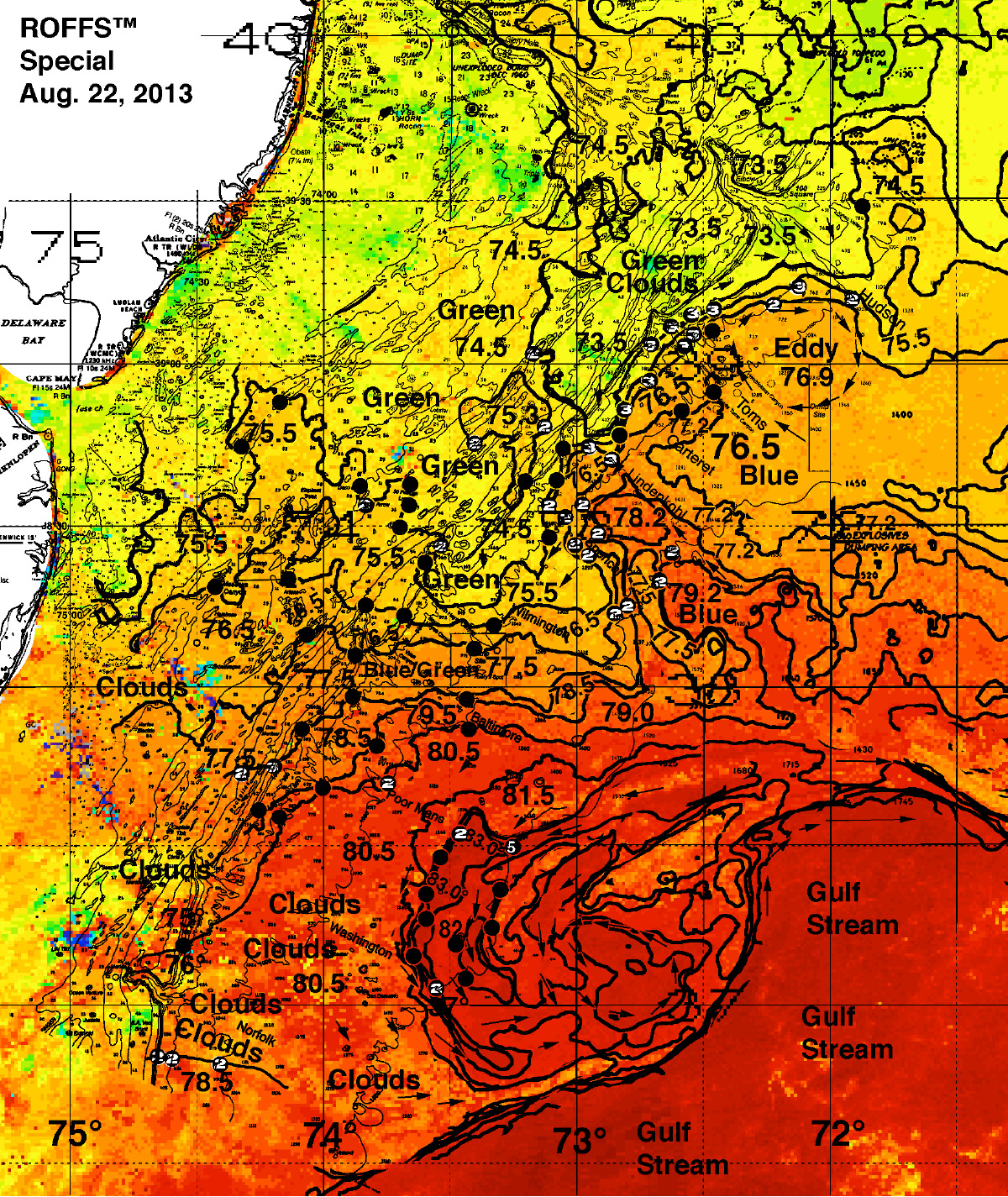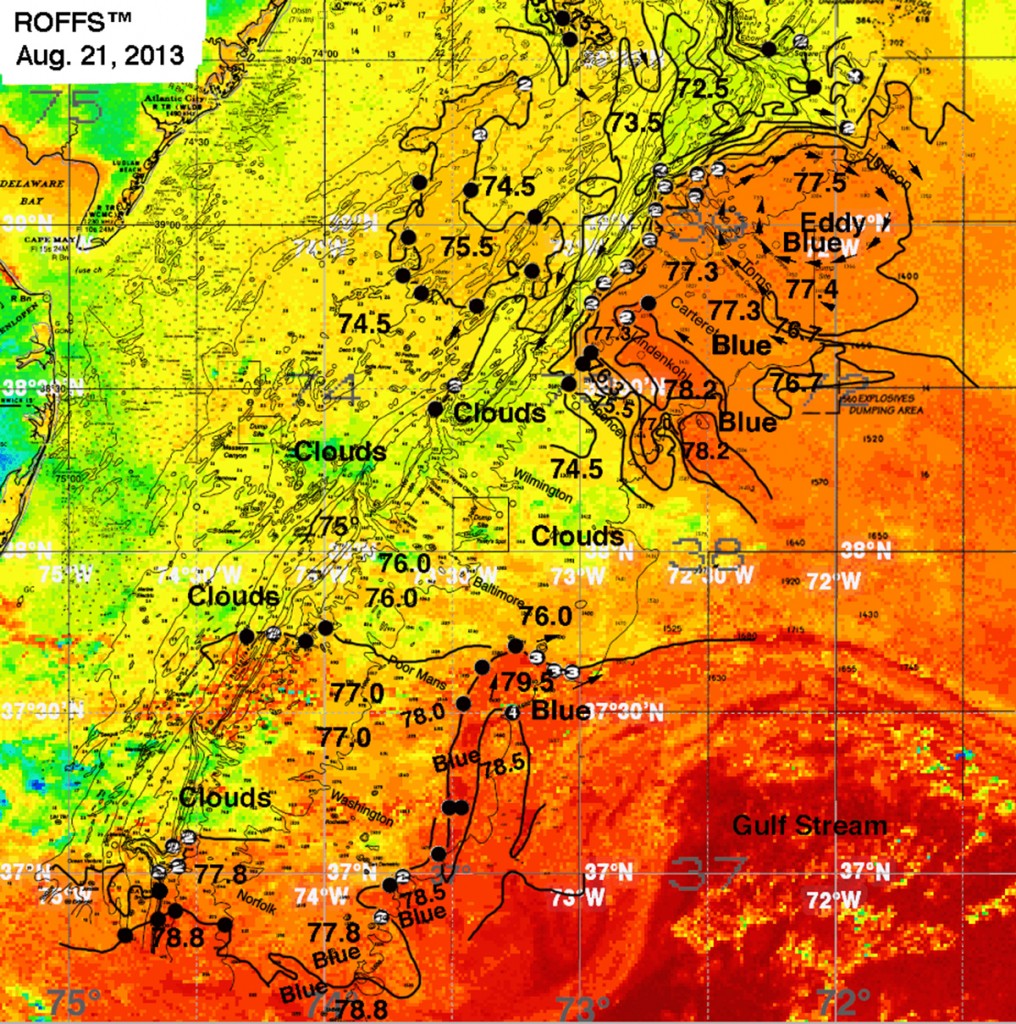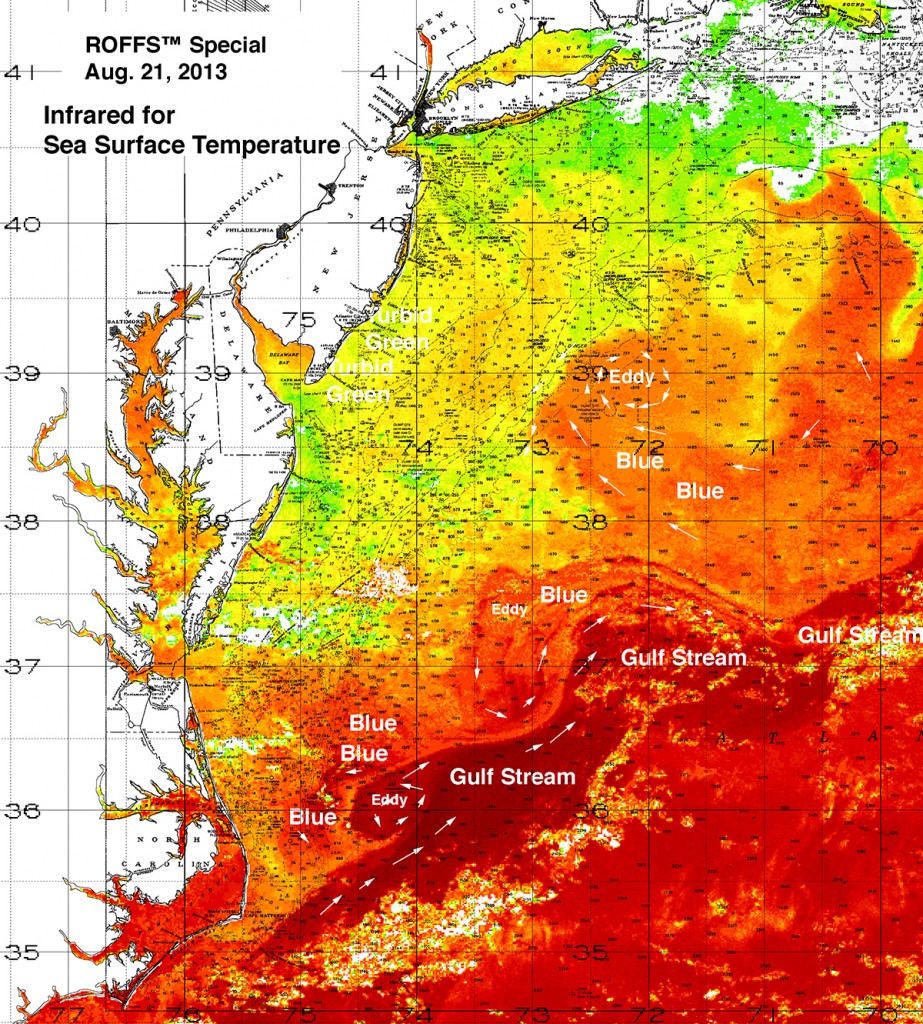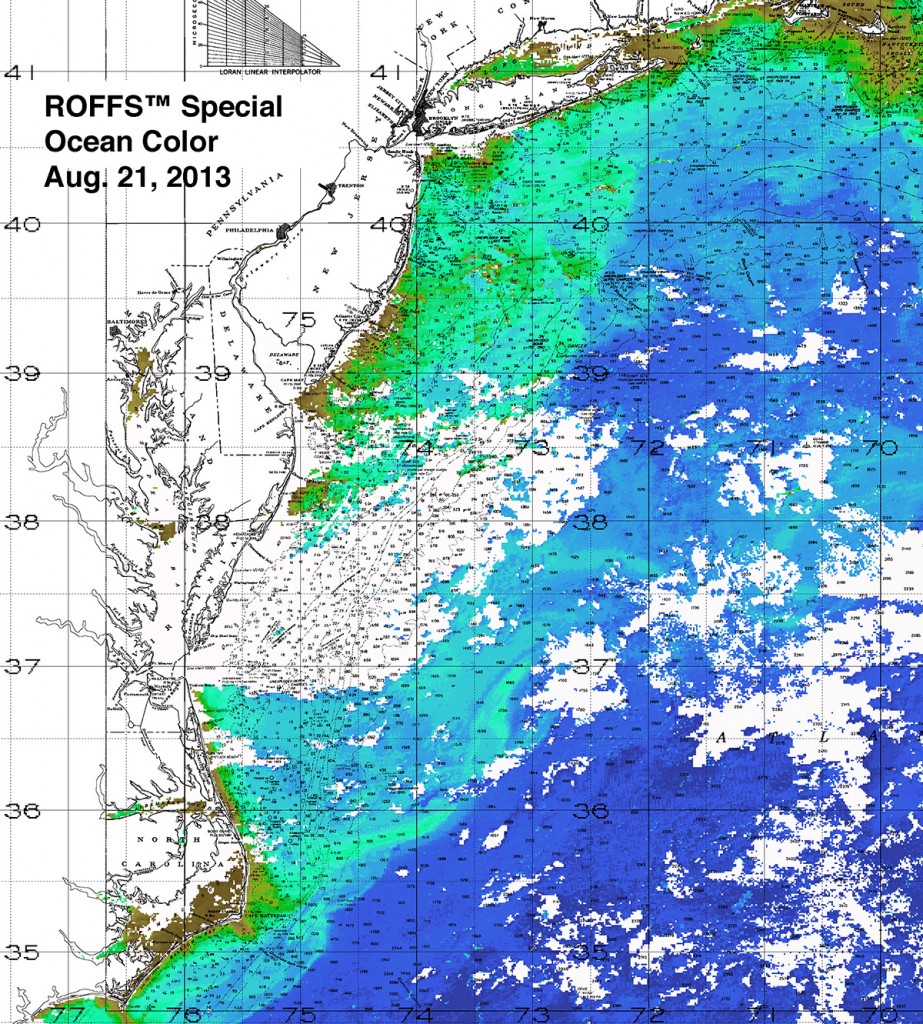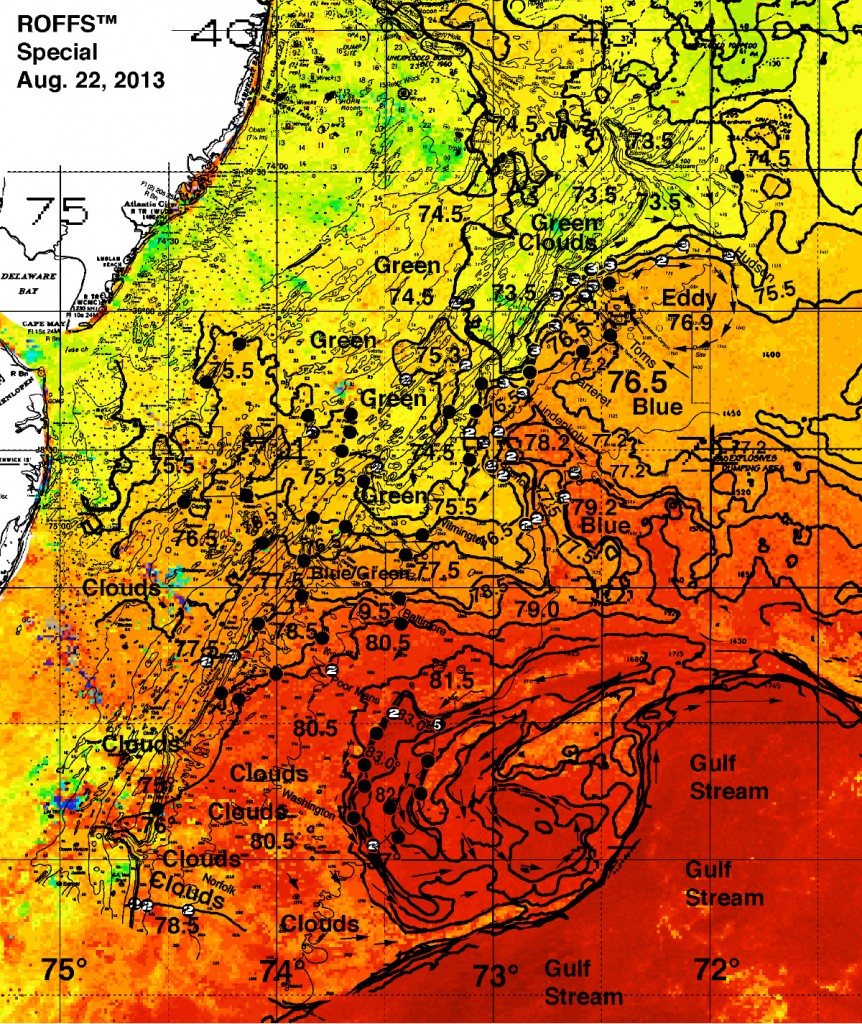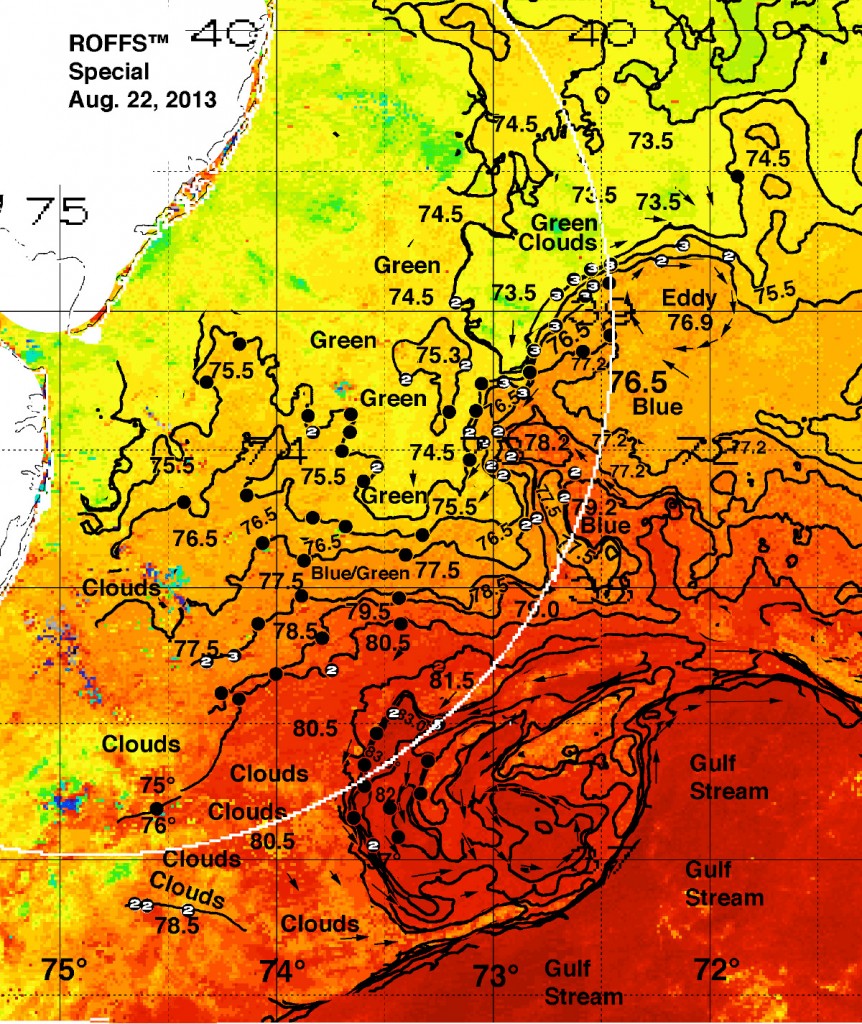ROFFER’S OCEAN FISHING FORECASTING SERVICE, INC.
TOLL FREE 800.677.7633 & (321) 723-5759 // 24 HR FAX (321) 723-6134//fish7@ROFFS.COM
ROFFS™ FISHERIES OCEANOGRAPHIC ANALYSIS
SPECIAL MID-ATLANTIC $500,000 ANALYSIS
UPDATED ON WED. 21 AUG. 2013 FOR WED. P.M. & THURS. FISHING ONLY
We are providing three separate graphics today. Two regional views from Atlantis Canyon to Cape Hatters: one derived from the infrared sensors for sea surface temperature (sst) from several satellites today (only) and one image derived from the last three days of ocean color satellite data; and a combined version of the ROFFS™ Hudson Canyon to Norfolk Canyon analyses. Clouds continue to obscure our views of some areas.
The Gulf Stream is directed northeastward from Cape Hatteras and there are two meanders (curves) in the current to approximately 72°00’W & 37°30’N. There is another meander east as well. The meander east of Oregon Inlet is associated with a counter-clockwise eddy (centered near 74°15’W & 36°10’N). This eddy is likely to move northeastward with the meander. There is a another blue Gulf Stream filament west and northwest of this eddy that is associated with the excellent fishing action east of Oregon Inlet. Between this filament and the Norfolk Canyon is another blue water mass that is providing favorable blue water conditions approximately 10 miles south of the Norfolk Canyon. It remains to be seen how many fish are concentrating along the boundary of this blue water and it may take another 2-3 days of stable favorable conditions for the fishing action to improve.
West of the other meander (72°00’W & 37°30’N) are three filaments of Gulf Stream water that were formed by relatively small counter-clockwise eddy features that are now approximately 60 miles east near 71°00’W & 37°15’N. Of note is that one of these filaments is over the 1400-1500 fathom depths east of the Poor Mans Canyon and another counter-clockwise eddy (centered near 73°15’W & 37°45’N) has pushed this filament northward and westward over the last 24 hours. While it remains to be seen what happens with this eddy, there are favorable blue water conditions that extend from the Poor Mans Canyon to the Washington Canyon over the 1400-1500 fathom depths. This filament was formed during the same time that another filament formed off the Gulf Stream that was associated with the good fishing action southeast of Virginia Beach and northeast of Oregon Inlet a week ago suggesting that there are marlin in this water. One non-tournament boat had fairly good marlin action this week along the boundary of this water. We anticipate that the western boundary of this water will remain stable for the next 24 hours.
East of Toms Canyon there is another eddy that is rotating in a clockwise direction. The blue water that is circulating around this eddy is coming from a mixture of Gulf Stream and North Atlantic Ocean water that is blue colored. The circulation of this eddy is pulling some of the water from the area south of the Atlantis Canyon, as well as, from the area immediately north of the Gulf Stream. As there appears to have been marlin, tuna, mahi and wahoo coming from the Gulf Stream off North Carolina it is logical to assume that there are these fish in these waters. However, it remains to be seen how many fish are in this diluted Gulf Stream water that is being pulled into the Toms Canyon to Lindenkohl Canyon areas. Apparently the eddy is not forceful enough to pull the new filament of relatively warmer blue water past the Lindenkohl Canyon. Also it appears that the blue water on the western and southwest side of the eddy is separating into two pools: one north of Berkeley Canyon and one south. Unfortunately most of this blue water is not being pushed over the 100 fathom depths of the canyons, except for the Toms Canyon where it is slowly moving over the canyon. This suggests that the fishing action over the Toms Canyon to Lindenkohl Canyon may not develop was much as it would if: 1) the blue water was coming directly from the Gulf Stream with an abundance of fish; 2) the blue water was pushing directed into the 100 fathom curve; 3) the water was not separating into at least two pools; 4) there was an abundance of bait fish waiting along the continental shelf edge; and 5) there was not a full moon. This is not to indicate that there will not be good fishing action forming over the next several days, especially over the Toms Canyon where the conditions are more favorable than the other areas. However, under the present conditions it may take 2-4 more days for the fishing action to improve substantially. There has been fishing action associated with this water, so hopefully the conditions and fishing action will improve faster than they presently suggest. Keep in mind also that the fish may not concentrate on the warm side of the water mass boundary, but rather in the relatively cooler and greener waters over these canyons. One should note that there have been blue marlin and white marlin seen and caught in this blue water from the Toms Canyon to the Spencer Canyon areas.
When looking at the ocean color image remember that the water east of Oregon Inlet is much bluer that the image suggests. The loss of blue color stems from the clouds and other atmospheric interference between the water and the satellites. Interpreting satellite data on the present cloudy conditions is substantially more complicated compared with the times when we have clear skies. The skies east of Cape Hatteras, NC and New Jersey have been substantially clearer the last few days, unlike east of Oregon Inlet, NC to the areas east of the Delaware Bay.
BOTTOM LINE: If you want to try to fish a totally different pool of water, then you should consider the Gulf Stream filament over 1500 fathom depths east of the Poor Mans Canyon, also the 1500 fathom depths southeast of the Washington Canyon or the blue water south of the Norfolk Canyon. There are new filaments of blue water moving toward the Lindenkohl Canyon that have not been tested yet as well. Thank you for using ROFFS™ this and every fishing trip as every fishing trip is important.
FULL MOON WARNING: Many times the tuna (and other species) fishing action slows during the daytime during a full moon as the fish are feeding at night. Experience suggests that the better fishing action with tuna during the full moon is at first light and last light of the day. Thus, be sure to get to the fish before first light so that you can start trolling early. The fish will bite before the human eye senses the light.
ROFFER’S OCEAN FISHING FORECASTING SERVICE, INC.
TOLL FREE 800.677.7633 & (321) 723-5759 // 24 HR FAX (321) 723-6134//fish7@ROFFS.COM
ROFFS™ FISHERIES OCEANOGRAPHIC ANALYSIS
SPECIAL MID-ATLANTIC $500,000 ANALYSIS
UPDATED ON THURS. 22 AUG. 2013 FOR THURS. P.M. & FRI. FISHING ONLY
We are providing this view from the Block Canyon to the Gulf Stream east of North Carolina. The first graphic is today’s graphic analysis combined into one image with the bottom topography and the latitude – longitude grid. The second one is the colorized infrared satellite image that we used to derive the final analysis and a white arc indicating the 125 nautical mile distance from the Cape May sea buoy.
Of particular note compared with yesterday’s view is that the Gulf Stream meander centered between 71°15’W – 72°15’N & 38°10-37°00’N is moving eastward. This motion is causing the trailing filaments of the blue Gulf Stream water (west of the meander to the 1400 fathom depths) to move in a south-southward direction between the Poor Mans Canyon and the Washington Canyon, but eastward south of the Washington Canyon. It remains to be seen how quickly that the fishing action over the Norfolk Canyon declines as this offshore motion typically results in a dispersion of the water and the fish over a broader area. If the fish over the Norfolk Canyon are well associated with the bait fish that are living and remaining in the canyon, then the fishing action is not likely to decline quickly over the next 24 hours. However, we anticipate a steady decline in the fishing action over the next few days as water and some of the fish will be pulled offshore. It will be interesting to see what happens as the water moves eastward, but the moon’s effect on the fishing action declines. Part of the decline in the fishing action over the Washington Canyon is related to this offshore motion. We anticipate that the offshore filament of blue Gulf Stream water will remain within tournament boundaries tomorrow.
Over the northern part of this area one can observe that the bluer and relatively warmer (78°F-79°F) filament of blended Gulf Stream water that was being pulled in a northwestward direction to the Lindenkohl Canyon is not being pulled northward. Between the 500-1000 fathom depths this water is moving in a southwestward direction as is the water over the 1500 fathom depths. It remains to be seen how much westward momentum that 78°F-79°F water has.
We hope that the presence of the relatively warmer and bluer water from these Gulf Stream filaments will bring in fish from the offshore waters that will help improve the fishing action between now and October.
BOTTOM LINE:
Thank you for using ROFFS™ this and every fishing trip as every fishing trip is important. While we did not have as much clear satellite data this week as we would have preferred to be able to understand the water motion as well as we usually do, we have provided the best possible oceanographic information to help you make decisions on where to fish and where not to fish. Sometimes knowing where not to fish is as important as knowing where to fish.
It is no secret that good fishing action has continued over the Norfolk Canyon area. However, it remains to be seen if the action will remain good tomorrow or that other larger fish will appear in some of the other areas where the conditions have been relatively favorable for three or more days. There have been large blue marlin and white marlin observed over the Lindenkohl Canyon to Toms Canyon in addition to the Norfolk Canyon over the last 24-48 hours, as well as, large white marlin over the 100 fathom curve of Poor Mans Canyon area. Hopefully you will have good fishing action tomorrow.
FULL MOON WARNING: Many times the tuna (and other species) fishing action slows during the daytime during a full moon as the fish are feeding at night. Experience suggests that the better fishing action with tuna during the full moon is at first light and last light of the day. Thus, be sure to get to the fish before first light so that you can start trolling early. The fish will bite before the human eye senses the light.

